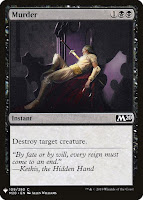Today I'll close out the month with another look at core sets (see previous post). From last time, there are 21 core sets to date in Magic's history. Adding up the cards in each, we have 6,451 total cards available in booster packs, but recent releases have offered further core set cards available only in preconstructed planeswalker decks (or other products), driving that number up to 6,725 cards. This counts everything (multiple copies of basic lands in each set, for example), so let's look at things in more detail, with a focus on reprints.
As you'd expect, reprints are common in core sets. Last time, we learned that 10 core sets featured only reprints. This time, I want to look at reprints as the occur in core sets only- in other words, I don't count if a given card was reprinted in an expansion or special release. Looking at the 21 core set releases, what do we see?
A few caveats: I don't count basic lands, and I count instances where cards were printed twice in one core set with differing artwork only once.
At a high level,
- 131 cards have been reprinted in 7 or more core sets, or 33% of the releases.
- 37 cards have been reprinted in 11 or more core sets, or 50% of the releases.
- 9 cards have been reprinted in 14 or more core sets, or 67% of the releases.
The 5 most commonly reprinted cards:
- Shivan Dragon, Giant Spider, Serra Angel (16 core sets)
- Nightmare, Unsummon (15 core sets)
One in each color, it just so happens:
Let's look at more numbers, focusing on those 131 cards that show up in 1/3 or more of core sets. Those cards, in total, account for 1,226 of the 6,725 core set cards- over 18%. Of these 131 cards,
- 111 (85%) first appeared in Alpha; see list below
- 1 first appeared in Beta (Circle of Protection: Black)
- 3 first appeared in Revised (Millstone, Ornithopter, Aladdin's Ring)
- 1 first appeared in 4th Edition (Spirit Link)
- 5 first appeared in 6th Edition (Gravedigger, Pacifism, Shock, Phantom Warrior, Rampant Growth)
- 2 first appeared in 7th Edition (Mind Rot, Duress)
- 2 first appeared in 8th Edition (Naturalize, Diabolic Tutor)
- 1 first appeared in 10th Edition (Cancel)
- 2 first appeared in Magic 2010 (Negate, Act of Treason)
- 1 first appeared in Magic 2011 (Plummet)
- 2 first appeared in Magic 2012 (Lava Axe, Titanic Growth)
Looking at types, rarities, and colors, we have the following breakdown:
- 46 creatures
- 27 enchantments
- 22 instants
- 20 artifacts (or artifact creatures)
- 16 sorceries
- 56 commons
- 41 uncommons
- 34 rares
- 23 White
- 20 Blue
- 22 Black
- 21 Red
- 25 Green
- 20 Artifact
As you'd expect, the first sets (Alpha through 5th Edition) have many of these most commonly reprinted cards (over 100 each).
- Revised and Fourth Edition have the most, at 114 cards
- Core Set 2021 has the least, at 5 cards
- There's a steady decline of commonly reprinted cards, as shown below
Of course, this is looking only at those reprinted in 7 or more core sets. Numbers swell dramatically when we include those printed (say) in 3 or more core sets. But that analysis is for another time.
This work further informs my 2021 goal: designing My Own Core (or "MOC") set, drawing from Magic's history and taking a cue from these frequently reprinted cards. Wizards is telling us something: with these 131 cards showing up in so many of the games foundational products (which is what core sets are- or at least were), they warrant likely (or mandatory) inclusion in MOC.













































